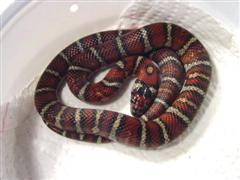Kingsnake - San Luis Potosi
Mexican King Snake, Mex Mex Scientific Name: Lampropeltis mexicana mexicana
Tue, 8th April, 2025 - 6:03 pm GMT
Sponsor Ads:

Alternative Name
Mexican King Snake, Mex Mex Scientific Name: Lampropeltis mexicana mexicanaBasic Info
Most San Luis Potosi Kingsnakes reach lengths between 24 and 32 inches, though some grow to 36 inches by maturity. They are characterized by a lovely silver coloration broken by red saddle markings. Some have a brownish base coloration, and some have black saddle markings. Regardless of the color, the saddles of San Luis Potosi Kingsnakes are usually accented by a white outline. A darker, forked marking usually spreads out over the head. The underside of a San Luis Potosi Kingsnake is usually a lighter brown or silver color. Sometimes a large tail blotch is evident. Other snakes show an entirely red, brown, or brownish gray underside. There are 21 to 25 dorsal scale rows. Males and females can only be accurately distinguished by probing.
Health
Adult San Luis Potosi Kingsnakes can be kept in a 20-gallon-long terrarium (24 x 12 x 12 inch). The substrate can be simple. Newspaper or plastic grass work well, or orchid bark chips or aspen bedding can be used if a natural look is desired. San Luis Potosi Kingsnakes should be maintained at about 80-85 degrees Fahrenheit during the day, with a warmer spot about 90-95 degrees Fahrenheit. Adults should have a nighttime temperature drop to between 65 and 70 degrees Fahrenheit (18 degrees Celsius). Juveniles should be maintained at about 75-80 degrees Fahrenheit at night. Though humidity should remain low, a water bowl should be present in the terrarium. Provide hiding places in both the cooler and warmer parts of the cage. Most San Luis Potosi Kingsnakes can be maintained on rodents of appropriate size; However, some, particularly wild-caught individuals and neonates, prefer lizards and will refuse mice. Breeding Most San Luis Potosi Kingsnake breeders recommend brumating these snakes at 55 degrees Fahrenheit, with a weak basking light, for about three months. After breeding, a gestation period between 24 and 46 days is average. Provide a nest box filled with damp peat or vermiculite. The average clutch size is 12, though clutches containing between 5 and 19 eggs are common. Infertility is a common problem. The temperature should be maintained between 80 and 83 degrees Fahrenheit. The eggs usually require an incubation period of 54 to 82 days. Many hatchling San Luis Potosi Kingsnakes can be started on pinky mice, though some may require lizards or lizard scented prey. Neonates are usually six to eight inches long.Habitat
They seem to prefer dryer, though not desert, areas like dry pine and oak forest or scrubland.Behavior
The San Luis Potosi Kingsnake has an attractive burnished silver and red banded pattern. These lovely reptiles are not too difficult to care for, and make strikingly beautiful captive snakes. San Luis Potosi Kingsnakes are active at night. In the wild, they inhabit rocky mountain territories. San Luis Potosi Kingsnakes feed mainly on lizards and small rodents. In captivity, they are usually fairly docile and will often calm down quickly with regular handling. However, some San Luis Potosi Kingsnakes are known to be problem feeders. Many can be tempted with lizards. San Luis Potosi Kingsnakes seem to be secretive snakes. They will often employ their hide box, which seems to be a necessary part of a cage set up for this species.Origin
MexicoHistory
Native to Mexico, San Luis Potosi Kingsnakes are normally located in mountain ranges surrounding the Chihuahua desert area. They are commonly found in San Luis Potosi, from whence their name arises, Durango, Zacatecas, Guanajuato, Nuevo Leon, Tamaulipas, and Coahuila, Mexico.Common Foods
feeds on lizards, birds, snakes, eggs, frogs, lizards and small mammalsSponsor Ads:
If you think education is expensive try Ignorance. -- Derek Bok, president of Harvard
Kingsnake - San Luis Potosi
Coded by: BGID® | ALL RIGHTS RESERVED Copyright © 2000-2025
Disclaimer | Privacy | Report Errors / Contact | Credits








 Why haven't we as a collective earth met with aliens yet?
Why haven't we as a collective earth met with aliens yet?  The Best Text Adventure You Will Ever Play! The official site:
The Best Text Adventure You Will Ever Play! The official site:  Homosexual behavior stems from the mind or genetics?
Homosexual behavior stems from the mind or genetics?  World EcoSystem - Biodiversity Changes - Who is on board and who isn
World EcoSystem - Biodiversity Changes - Who is on board and who isn  Mouthwash - Mouthrinse - Mouth Sores - Healing Infections - Gingivitis
Mouthwash - Mouthrinse - Mouth Sores - Healing Infections - Gingivitis  Treatment for Depression
Treatment for Depression  Ultra radical and violent Islamist group that even rivals Al Qaeda
Ultra radical and violent Islamist group that even rivals Al Qaeda  An idea to have teachers who want to carry guns to school undergo some level of police training will be left up to local school districts and police departments.
An idea to have teachers who want to carry guns to school undergo some level of police training will be left up to local school districts and police departments.